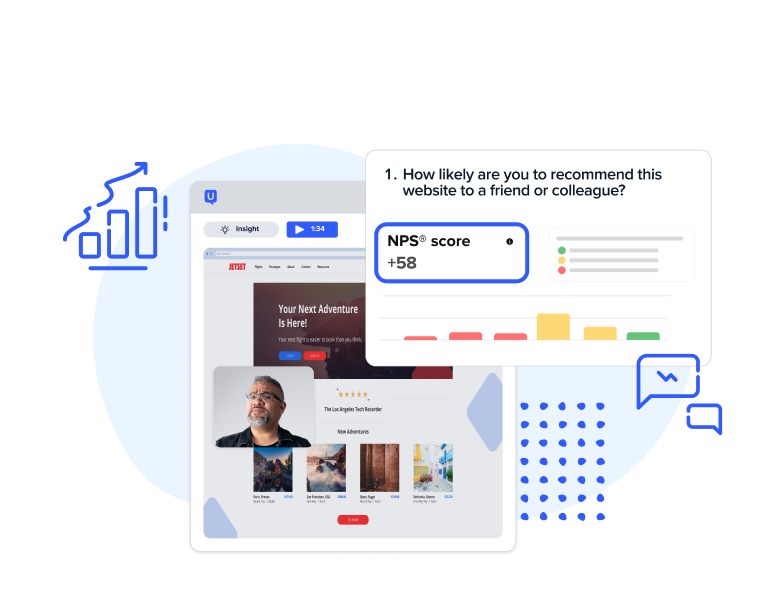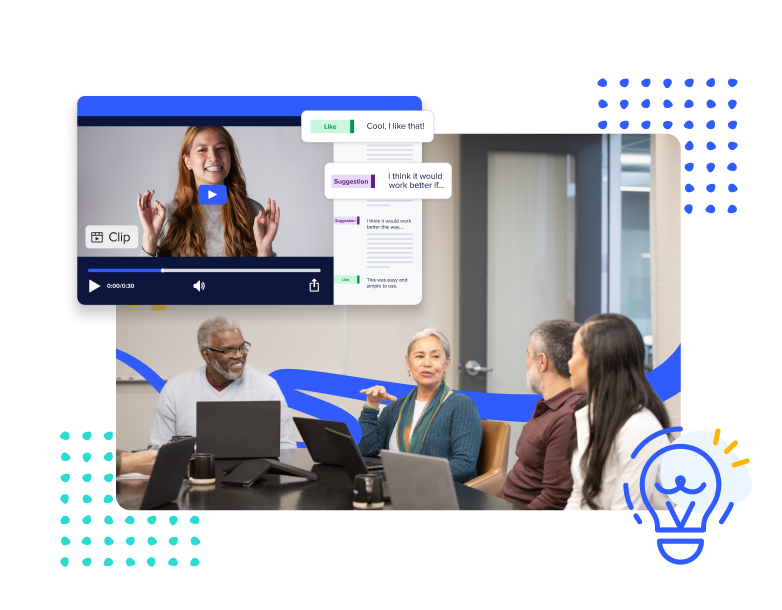
In this guide
A guide to customer-first innovation and discovery
A guide to customer-first innovation and discovery

Unlocking the future of product innovation
In today’s fast-paced and competitive business environment, staying ahead of market trends and meeting evolving customer needs are more crucial than ever. To drive meaningful product innovation, businesses must continuously test and validate their ideas through discovery and innovation research. While customer-focused innovation creates competitive advantages, customer loyalty, and potential for growth, innovation without customer connection can fall flat, leading to wasted resources and erosion in customer trust.
This guide explores why investing in discovery studies is not just a nice-to-have but a business-critical strategy for growth. Whether you're in tech, retail, ecommerce, financial services, consumer goods, healthcare, or any other sector, this guide will provide actionable insights into ways to harness the power of customer-driven research to fuel innovation and uncover new opportunities.
Why discovery and innovation research is critical to success
Innovation is the lifeblood of any business looking to differentiate itself in a crowded market. It goes beyond merely developing new products; it’s about uncovering unmet customer needs, identifying emerging trends, and validating ideas early to ensure they resonate with your target audience. Ongoing discovery and innovation research is vital for:
- Uncovering unmet needs and pain points: Continuous research enables organizations to identify areas where customers are underserved, uncovering opportunities for differentiation.
- Validating new concepts: Before committing resources, businesses can ensure that new ideas, whether products, features, or services, align with customer desires and market demand.
- Gaining competitive advantage: By understanding gaps in the market before competitors do, companies can capture new opportunities and differentiate their offerings.
- Optimizing customer experiences: Discovery research drives improvements to customer journeys, enhancing satisfaction, loyalty, and retention.
- Achieving faster time-to-market: With the right insights, companies can accelerate product development, ensuring faster, more informed decision-making.
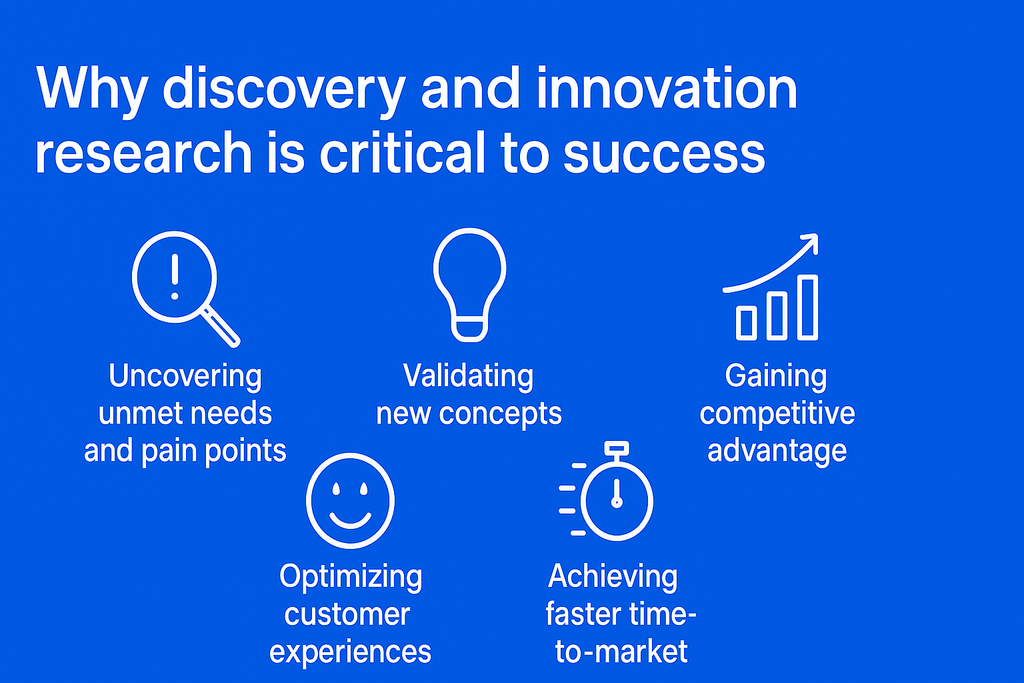
Ultimately, discovery and innovation research empower organizations to anticipate market shifts, capitalize on new opportunities, and stay ahead of customer expectations.
Challenges in discovery and innovation testing
While the benefits of discovery research are clear, many teams encounter significant hurdles that prevent them from conducting effective innovation studies. These challenges include:
- Lack of resources or dedicated teams: Many organizations struggle with allocating sufficient budgets or staffing for continuous research efforts, especially when innovation is not seen as an immediate priority.
- Time constraints: Tight product development cycles often lead teams to prioritize speed over research, sidelining necessary discovery studies in favor of quick prototypes and launches.
- Internal biases: Teams may rely on internal feedback or assumptions rather than gathering unbiased insights directly from real customers, leading to misaligned product development.
- Difficulty engaging the right audience: Reaching a diverse and relevant set of customers can be time-consuming and expensive, especially when targeting niche markets or global audiences.
- Outdated or inconsistent data: Traditional research methods can be slow and expensive, leaving teams with old or incomplete data that doesn't reflect the current market dynamics.
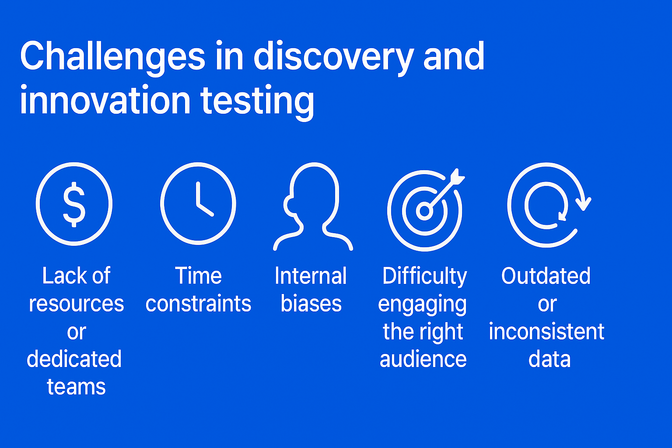
As a result, many teams resort to alternatives instead of conducting proper discovery or customer research. These alternatives may include relying on internal feedback and gut instincts, reacting to competitor products, or using outdated or irrelevant data to guide innovation decisions. While these approaches may appear faster, they often provide a limited perspective on market potential and can lead to a reactive product roadmap. This approach risks investing in costly innovation initiatives and misaligned products that fail to meet customer needs, ultimately preventing the organization from leading the market and achieving meaningful innovation.
What is the impact of not conducting proper discovery and innovation research?
Failing to prioritize discovery and innovation research can lead to a variety of risks and negative outcomes:
- Missed market opportunities: Without continuous insights, companies risk developing products that don’t address customer pain points or entering a market that is already saturated.
- Wasted resources: Without proper validation, organizations might invest heavily in products or features customers don’t value, leading to sunk costs.
- Decreased customer satisfaction: Products that fail to meet customer expectations or solve real problems can lead to dissatisfaction, negative reviews, and churn.
- Loss of competitive edge: Companies that neglect discovery research risk falling behind as competitors capitalize on customer insights and innovate faster.
- Brand reputation damage: A failure to innovate based on customer needs can damage a company’s reputation, making it harder to regain customer trust.
In short, neglecting discovery and innovation research is a recipe for stagnation. Businesses that don’t continuously refine their products based on customer feedback risk losing market relevance.
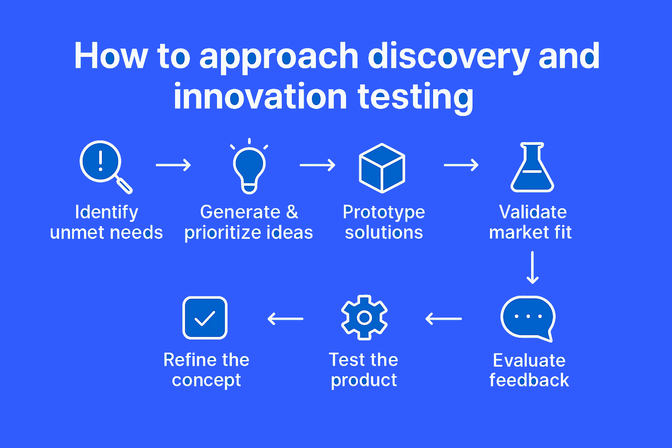
A step-by-step guide: how to approach discovery and innovation testing
Innovation and discovery research is a critical part of any successful product development process. It enables teams to identify market gaps, validate ideas early, and ensure that solutions meet customer needs. Below is a step-by-step guide for each stage in the discovery and innovation process, with expert guidance and best practices to ensure you maximize your insights and drive real business outcomes.
1. Identify unmet needs & emerging opportunities
Objective: Discover gaps in the market, evolving customer behaviors, and unmet needs.
Considerations: The first step in any innovation process is to identify what your customers truly need and want—before your competitors do. This involves not just solving existing problems but anticipating future needs. Focus on understanding your customers’ pain points, desires, and challenges in-depth. Be proactive in uncovering hidden needs that customers may not even be able to articulate yet.
Steps to implement:
- Conduct customer interviews: Engage with current and potential customers through live interviews to uncover emotional drivers and unmet needs.
- Use ethnographic research: Observe customers in their natural environments to gain insights into behaviors and pain points that they may not express in surveys or interviews.
- Leverage surveys and open-ended questions: Use tools like unmoderated testing and open-ended surveys to gain broad insights into user frustrations and needs.
- Review industry trends: Keep an eye on emerging technologies and market shifts that could influence future customer needs.
- Look beyond the obvious: Dig into both existing and potential customer segments. Explore underserved niche markets and the broader societal or technological shifts influencing customer behaviors.
How UserTesting helps:
- Live Conversations: Direct, qualitative insights from real customers help identify pain points.
- Unmoderated testing: Gather quick feedback from diverse customer segments at scale.
- Surveys: Gather and quantify in-depth, actionable feedback on customer challenges.
Expert tip: Don’t just rely on what your customers say—they may not always be able to articulate all their challenges or desires. Combine qualitative and quantitative data for a comprehensive view. Also, ensure that you're not overly influenced by current product offerings; think ahead to what could be valuable in the next 3–5 years.
ON-DEMAND WEBINAR
Continuous discovery: transform your product development process
2. Generate & prioritize new ideas
Objective: Develop a pipeline of innovative concepts and evaluate their potential impact.
Considerations: Idea generation is about creative brainstorming and the exploration of diverse solutions. It’s crucial to generate a wide array of concepts without immediately judging them, followed by a rigorous prioritization process. Be sure to balance creativity with feasibility, ensuring that ideas are both innovative and executable.
Steps to implement:
- Host ideation workshops: Bring together cross-functional teams for brainstorming sessions. Use techniques like design thinking or SCAMPER to generate diverse ideas.
- Leverage customer feedback for ideas: Use discovery insights from customer conversations to inform new ideas or product concepts.
- Apply innovation filters: Once ideas are generated, assess them for desirability, feasibility, and viability. Use a framework like the Innovation Matrix to evaluate concepts.
- Conduct idea prioritization: Prioritize ideas based on potential impact, customer need, and alignment with business objectives. Tools like the Impact vs. Effort Matrix can help in selecting the best ideas to move forward.
- Validate concepts early: Use quick, low-cost methods (like sketches, mockups, or wireframes) to test early concepts before developing fully formed prototypes.
How UserTesting helps:
- Concept testing & preference testing: Validate which ideas resonate with users before investing resources.
- Matrix Questions & Surveys: Prioritize ideas based on user feedback and market viability.
Expert tip: In the ideation phase, encourage a "fail-fast" mentality. Rapidly prototype and iterate on ideas to validate them early. Avoid the trap of focusing too heavily on internal biases or “safe” ideas. Innovation thrives when you push boundaries.
3. Develop early concepts & prototypes
Objective: Create low-fidelity solutions to visualize ideas and gather initial feedback.
Considerations: At this stage, the focus is on quickly testing ideas in a tangible form. Prototypes should be low-cost and low-fidelity but should communicate the core idea effectively. Rapid prototyping allows you to gather valuable feedback before investing heavily in development.
Steps to implement:
- Create simple prototypes: Use basic tools (like wireframes, mockups, or paper sketches) to visualize concepts. These need not be polished but should effectively demonstrate the concept’s value.
- Test with real customers: Use unmoderated tests or live conversations to get early feedback on prototypes. Ensure your testers match the target audience to get actionable insights.
- Include core features: Prioritize the most critical features of your prototype to gauge customer reactions and uncover any critical issues.
- Iterate quickly: Incorporate feedback and refine the prototype. The goal is not perfection but learning fast and making adjustments.
- Use A/B testing: When possible, run A/B tests with different iterations of the concept to see which resonates best with users.
How UserTesting helps:
- Prototype testing: Quickly gather feedback on wireframes, mockups, and sketches.
- Think out loud: Have the participants talk through their reactions as they explore the prototype or react to your early concepts, then use the transcripts and sentiment tags to identify key takeaways and areas requiring attention.
- Task-based feedback: Ensure that prototypes solve real customer problems before going further.
Expert tip: Don’t wait for perfection—start testing concepts as soon as they are reasonably clear. It’s important to collect feedback on the most critical assumptions before committing resources to more refined prototypes or full product development.
GUIDE
How to test prototypes that lead to confident, customer-centric design
4. Validate initial market fit
Objective: Test early-stage concepts with potential users to assess desirability and usability.
Considerations: At this point, you need to validate whether the idea truly meets customer needs and whether it will be embraced by the market. Focus on understanding the "why" behind user preferences, not just the "what." This helps ensure your product aligns with customer desires and market demands.
Steps to implement:
- Conduct usability testing: Run tests with target users to assess how easily they can navigate and use your product concept. Look for pain points in user experience and identify potential barriers.
- Gather feedback on core features: Validate the key features or benefits that make your product unique. Are they compelling enough for customers to switch from current solutions?
- Perform sentiment analysis: Use tools to measure user sentiment toward the product. Are they excited? Indifferent? Frustrated? This will guide your next steps.
- Utilize concept testing: Run tests to understand which features customers value most and how they perceive your product relative to competitors.
How UserTesting helps:
- Sentiment analysis & rapid iteration testing: Quickly uncover how your product addresses real user needs, then iterate, test, repeat.
- Competitive benchmarking: Compare your concepts with existing solutions or previous iterations to gauge differentiation.
- Open-ended survey questions: Use the open-ended questions and the AI survey themes to quickly extract key insights and get to the why.
Expert tip: In this phase, be open to rejection and consider pivoting or refining your concept based on user feedback. Strong validation early on will save you from making costly mistakes later.
5. Refine & iterate based on feedback
Objective: Adapt concepts based on user reactions, usability insights, and market validation.
Considerations: Innovation doesn’t end when feedback is gathered—it’s a process of constant iteration. Balancing conflicting feedback can be challenging, but refining based on real-world insights is key to ensuring the product remains aligned with customer expectations.
Steps to implement:
- Analyze user feedback: Systematically categorize feedback into actionable insights. Focus on patterns rather than isolated comments.
- Identify priorities for improvement: Not all feedback is equally important. Prioritize changes based on their potential to improve usability and meet customer needs.
- Iterate on design: Implement changes to the prototype or product and continue testing. Iteration is about continuous improvement, so make sure feedback loops are ongoing.
- Stay open to pivoting: If user feedback consistently points to a need for a major shift, consider pivoting rather than persisting with a failing concept.
How UserTesting helps:
- Highlight Reels: Quickly extract key insights from user feedback to guide decision-making, and share key moments with stakeholders.
- Figma testing & A/B testing: Test interactions and variations of concepts to refine design and usability.
Expert tip: Ensure that you have a structured process for integrating feedback into your development cycle. The ability to quickly pivot or adjust based on customer input is what separates successful products from those that fail.
6. Evaluate business viability & feasibility
Objective: Assess whether the innovation is scalable, financially viable, and technically feasible.
Considerations: At this stage, it’s important to understand whether your innovation can realistically be turned into a profitable product. This is where you assess market fit, business model, and scalability. Focus on ROI, costs, and technical challenges.
Steps to implement:
- Conduct cost-benefit analysis: Estimate development, production, and marketing costs against potential revenue. Consider pricing models, customer acquisition costs, and scalability.
- Test with real-world data: Run small-scale trials or beta tests to understand how the product performs in the real world.
- Get internal buy-in: Present findings to stakeholders and get alignment on the product’s business potential.
- Measure scalability: Consider whether your infrastructure, supply chain, and marketing strategies can scale as demand grows.
How UserTesting helps:
- Video Feedback & competitive benchmarking: Provide visual and emotional context for decision-making, evaluate how your idea stacks up against competitive alternatives.
- Value Perception Testing: Measure how much users are willing to pay for your product.
Expert tip: This is the stage where product-market fit meets business viability. Be sure to involve finance, operations, and other stakeholders early to avoid surprises down the line.
7. Test go-to-market readiness
Objective: Ensure that the product, messaging, and positioning are clear and resonating with your target audience before launch.
Considerations: It’s not only important to validate whether your product will be accepted by the market before launching but also validate if the product narrative and value props are resonating with your audience. Testing your messaging, positioning, and marketing materials ensures you’re set up for market success.
Steps to implement:
- Run message testing: Test iterations of the key messaging with your target audience to see which option best resonates and communicates the value proposition.
- Validate pricing: Conduct price sensitivity studies to understand what customers are willing to pay for your product.
- Conduct beta testing: Offer a limited release to a subset of your target market to gather feedback on the product’s performance and gather final impressions.
- Align cross-functional teams: Ensure that product, marketing, and sales teams are all aligned with the product’s value proposition, messaging, and customer journey.
How UserTesting helps:
- Message testing: Test messaging and positioning with real customers before launch. Do they understand the product and are the values coming through clearly? Ask participants to talk through their thoughts and provide context.
- UX Benchmarking: Ensure product usability aligns with customer expectations.
Expert tip: Use both quantitative methods like surveys and interaction testing in combination with qualitative methods including think-out-loud and Live Interview testing to make the findings more actionable. This stage is often overlooked, but ensuring alignment across teams and validating market readiness will prevent costly missteps when your product is launched.
8. Monitor market reception and adapt over time
Objective: Track real-world performance and evolve the product based on user adoption and competitive shifts.
Considerations: Once the product is in the market, continuous monitoring is essential. Stay close to customer feedback and adapt your product as necessary. This is how you stay competitive and ensure that your innovation doesn’t stagnate.
Steps to implement:
- Track key metrics: Measure adoption rates, user engagement, and customer satisfaction post-launch.
- Gather post-launch feedback: Use customer surveys, reviews, and social listening to understand ongoing issues or opportunities for improvement.
- Conduct longitudinal studies: Continue to test and monitor the product’s performance over time to adapt to evolving customer needs and market trends.
- Refine based on performance: If needed, release updates or iterate on the product to keep it competitive.
How UserTesting helps:
- Longitudinal studies: Continuously track customer sentiment and behavior over time.
- Post-Launch usability testing: Gather feedback after launch to continually optimize and improve.
Expert tip: The market changes constantly. To remain successful, continue testing and refining your products based on real-world data to ensure long-term relevance and growth.
Winning the market with customer-driven innovations
Effective discovery and innovation research are vital to staying ahead in today’s competitive market. By integrating ongoing customer insights into every stage of the product development lifecycle, organizations can fuel innovation, mitigate risks, and deliver products that resonate with customers. UserTesting provides the agile, real-time tools and insights necessary to help businesses take advantage of market opportunities and stay ahead of evolving customer needs.
Start unlocking new opportunities by integrating UserTesting into your discovery and innovation process today.

